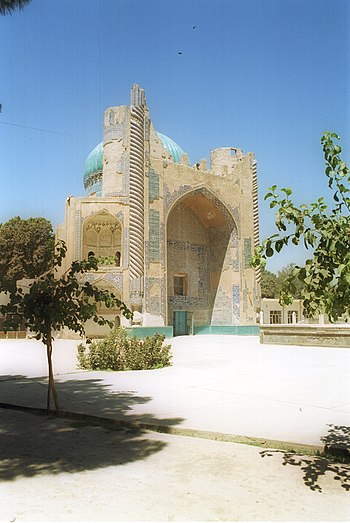
Balkh is a town in Afghanistan.
Understand
[edit]Balkh has been inhabited since before 1000 BCE, and is mentioned in the Hindu Vedas. It was the capital of the historic region of Bactria, even before the arrival of Alexander the Great, and of a Greco-Bactrian kingdom ruled by some of Alexander's successors. It was sacked twice by the Mongols, first by Ghengis Khan and later by Tamerlane. Both of the great medieval travellers, Marco Polo and Ibn Battuta, visited it.
The city was the regional capital until the 19th century when it was mostly abandoned during an epidemic and Mazar-e Sharif took over. Today Mazar is the largest and most important city of the region.
Talk
[edit]Both of Afghanistan's main languages, Dari and Pashto, are spoken here, but Dari is more common in this region. Other languages such as Tajik and Uzbek are also heard. Because it is a border region, some people will speak Russian.
Compared to the rest of the country, many citizens of Balkh can speak English. There are English schools/lessons and computer courses are also taught (such as Microsoft Office programs). A traveller will be hard pressed not to run into one of the teachers and be invited into their home. The young students are shy about using their English.
Get in
[edit]Balkh is easily reachable from Mazar-e Sharif by shared taxi for about 20 afghani. Look for the passengers sitting in the open boot of some cars. The road passes through a fort with destroyed tanks and APCs; the fort was probably a road block during the Warlord and Taliban period. The landscape before and around the town is fields. South of the town at the turnoff is a large mound that was probably a watchtower.
Get around
[edit]See
[edit]The town is completely enclosed by its ancient fortifications; brick and mud walls at least 30 feet high and in good condition. They can be climbed, giving views of the countryside and the town. At the north end is another larger mound that was the fortress. The walls slope on the outside and are vertical on the inside, giving an impression from the inside of being very tall. Turrets along the walls are in varying states of decay, providing glimpses of building techniques.
The town has a central park, where children play soccer or volleyball. At one end are the ruins of a tiled mosque; at the other, the gate of a madrassa. Again the construction technique of the madrassa can be seen. As the park is full of trees and small shops surround the park, it is difficult to take photos of the madrassa. Full shots of the mosque are easy.
- 1 Bala Hissar (on the northern edge of the city). A huge fortress built by the Timurid in the 15th century on the site of an Achaemenid fort where Alexander the Great married the beautiful Roxanne.
- 2 Shrine of Khoja Abu Nasar Parsa. Also known as Bala Hasar, this shrine dominates the park in the centre of the town. It was built in the 15th century in the Timurid style.
- 3 Dargah of Rabia Balkhi. Adjacent to the Parsa shrine is this small tomb of the famous female Persian poet. She was sealed in a basement by her brother after having an affair, and wrote her most famous poem in her own blood on the wall as she died.
- 4 Noh Gonbad (Haji Piyada) Mosque (2km south of city center). Well worth a visit. Its history is unclear but it is certainly one of Afghanistan's most important historical buildings. Possibly dating from Zoroastrian times, the remains are now under a protective roof, and are worth the bumpy 2-km drive from the main Balkh - Mazar road. Head south from the centre of Balkh, cross the main east-west road and keep going. After 500 metres you'll see a sign (in English) telling you to turn right.
- 5 Tepe-i Rustam (near the bus stand). Remains of a Buddhist stupa. Accounts of Chinese Buddhist monk and traveler Xuanzang, who visited Balkh in 630 AD, indicate the existence of a significant number of Buddhist monasteries in the city.
Do
[edit]Buy
[edit]Eat
[edit]Drink
[edit]Sleep
[edit]Go next
[edit]

